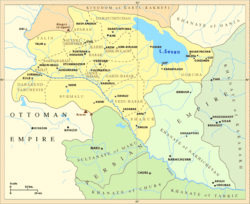纳希切万汗国
纳希切万汗国(波斯语:خانات نخجوان;阿塞拜疆语:Naxçıvan xanlığı)是波斯附庸的高加索诸汗国之一[5],建于1747年,首府为纳希切万[6],其疆域包括今日阿塞拜疆的纳希切万自治共和国与亚美尼亚的瓦约茨佐尔省。1827年最后一次俄罗斯-波斯战争中纳希切万汗国被俄罗斯帝国占领,隔年波斯被迫签订土库曼恰伊条约将其割让给俄罗斯,后者将纳希切万汗国与埃里温汗国合并为亚美尼亚州。
| 纳希切万汗国 خانات نخجوان | |||||||||
|---|---|---|---|---|---|---|---|---|---|
| 1747年—1828年 | |||||||||
|
国旗 | |||||||||
 1800年的纳希切万汗国与埃里温汗国领土 | |||||||||
| 地位 | 汗国(波斯附庸)[1] | ||||||||
| 首都 | 纳希切万 | ||||||||
| 常用语言 | 波斯语(官方语言)[2][3][4] | ||||||||
| 历史 | |||||||||
• 建立 | 1747年 | ||||||||
• 终结 | 1828年 | ||||||||
| |||||||||
历史 编辑
纳希切万汗国的领土过去属于萨法维王朝的埃里温省,在1603年-1618年奧斯曼-萨非战争期间受奧斯曼帝国军事威胁,波斯沙阿阿拔斯一世曾下令将当地人口迁往波斯本土[7]。1635年-1636年与1722-1736年当地曾两度被奧斯曼帝国占领。阿夫沙尔王朝时期此地曾为埃里温汗国的一部分,后来改由另一位汗统治,自成一汗国[8]。
1804-1813年俄罗斯-波斯战争中,俄军将领伊万·古多维奇一度占领纳希切万,后于1813年古利斯坦条约签订后归还给波斯[9]。1827年最后一次俄罗斯-波斯战争时,卡札尔王朝储君阿巴斯·米尔札任命伊赫桑·汗·坎加利为指挥官,据守纳希切万汗国战略意义重要的要塞阿巴薩巴德堡,俄军围城后,伊赫桑汗私下与俄军将领伊万·帕斯克维奇联络,于同年7月22日开城投降[10],1828年2月,波斯被迫签订土库曼恰伊条约,将纳希切万汗国与其他阿拉斯河以北的领土割让给俄罗斯帝国,后者将纳希切万汗国与埃里温汗国合并为亚美尼亚州。伊赫桑汗改名为伊赫桑·汗·纳希切万斯基(Ehsan Khan Nakhichevansky)并成为俄军将领,继续担任当地统治者[11]。
注释 编辑
- ^ Bournoutian, George A. The 1820 Russian Survey of the Khanate of Shirvan: A Primary Source on the Demography and Economy of an Iranian Province prior to its Annexation by Russia. Gibb Memorial Trust. 2016: xvii. ISBN 978-1909724808.
Serious historians and geographers agree that after the fall of the Safavids, and especially from the mid-eighteenth century, the territory of the South Caucasus was composed of the khanates of Ganja, Kuba, Shirvan, Baku, Talesh, Sheki, Karabagh, Nakhichivan and Yerevan, all of which were under Iranian suzerainty.
- ^ Swietochowski, Tadeusz. Russian Azerbaijan, 1905-1920: The Shaping of a National Identity in a Muslim Community. Cambridge: Cambridge University Press. 2004: 12. ISBN 978-0521522458.
(...) and Persian continued to be the official language of the judiciary and the local administration [even after the abolishment of the khanates].
- ^ Pavlovich, Petrushevsky Ilya. Essays on the history of feudal relations in Armenia and Azerbaijan in XVI - the beginning of XIX centuries. LSU them. Zhdanov. 1949: 7.
(...) The language of official acts not only in Iran proper and its fully dependant Khanates, but also in those Caucasian khanates that were semi-independent until the time of their accession to the Russian Empire, and even for some time after, was New Persian (Farsi). It played the role of the literary language of class feudal lords as well.
- ^ Homa Katouzian, "Iranian history and politics", Published by Routledge, 2003. pg 128: "Indeed, since the formation of the Ghaznavids state in the tenth century until the fall of Qajars at the beginning of the twentieth century, most parts of the Iranian cultural regions were ruled by Turkic-speaking dynasties most of the time. At the same time, the official language was Persian, the court literature was in Persian, and most of the chancellors, ministers, and mandarins were Persian speakers of the highest learning and ability."
- ^ William Bayne Fisher, Peter Avery, Ilya Gershevitch, Gavin Hambly, Charles Melville. The Cambridge History of Iran: From Nadir Shah to the Islamic Republic. Cambridge University Press, 1991. ISBN 0521200954, 9780521200950
- ^ Hewsen, Robert H. Armenia: a Historical Atlas. University of Chicago Press. 2001: map 149.
- ^ Oberling, P. Kangarlu. Encyclopedia Iranica. [2009-02-01]. (原始内容存档于2020-11-29).
- ^ Bournoutian, George A. (1992). The Khanate of Erevan Under Qajar Rule, 1795-1828. p. 32.
- ^ Записки о службе генерал-фельдмаршала графа И. В. Гудовича, составленные им самим. [2020-12-27]. (原始内容存档于2018-10-07) (俄语).
- ^ Ekbal, Kamran. ʿAbbāsābād. Encyclopedia Iranica. [2009-02-01]. (原始内容存档于2011-04-29).
- ^ Иванов Р. Н. Именем Союза Советских… Жизнь и гибель комбрига Нахичеванского. Герои Отечества. 2007.
参考文献 编辑
- Floor, Willem M. Titles and Emoluments in Safavid Iran: A Third Manual of Safavid Administration, by Mirza Naqi Nasiri. Washington, DC: Mage Publishers. 2008: 248. ISBN 978-1933823232.
- Oberling, P. 存档副本. Encyclopaedia Iranica, Vol. XV, Fasc. 5: 495. 2010 [2020-12-27]. (原始内容存档于2020-11-29).
|article=和|title=只需其一 (帮助)
外部链接 编辑
| 维基共享资源上的相关多媒体资源:纳希切万汗国 |
